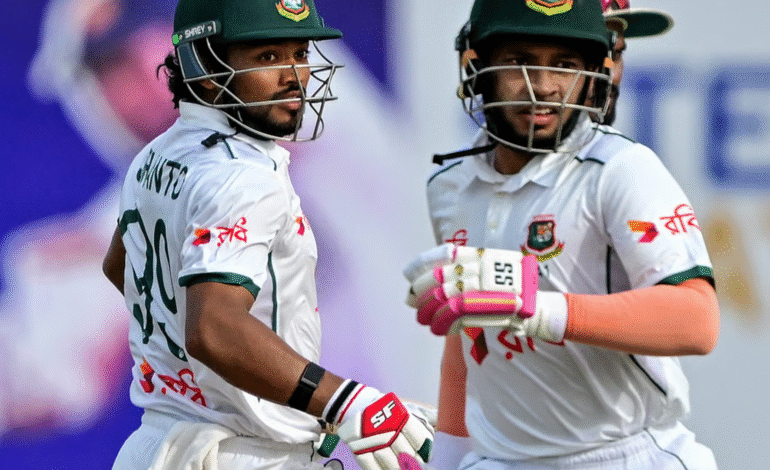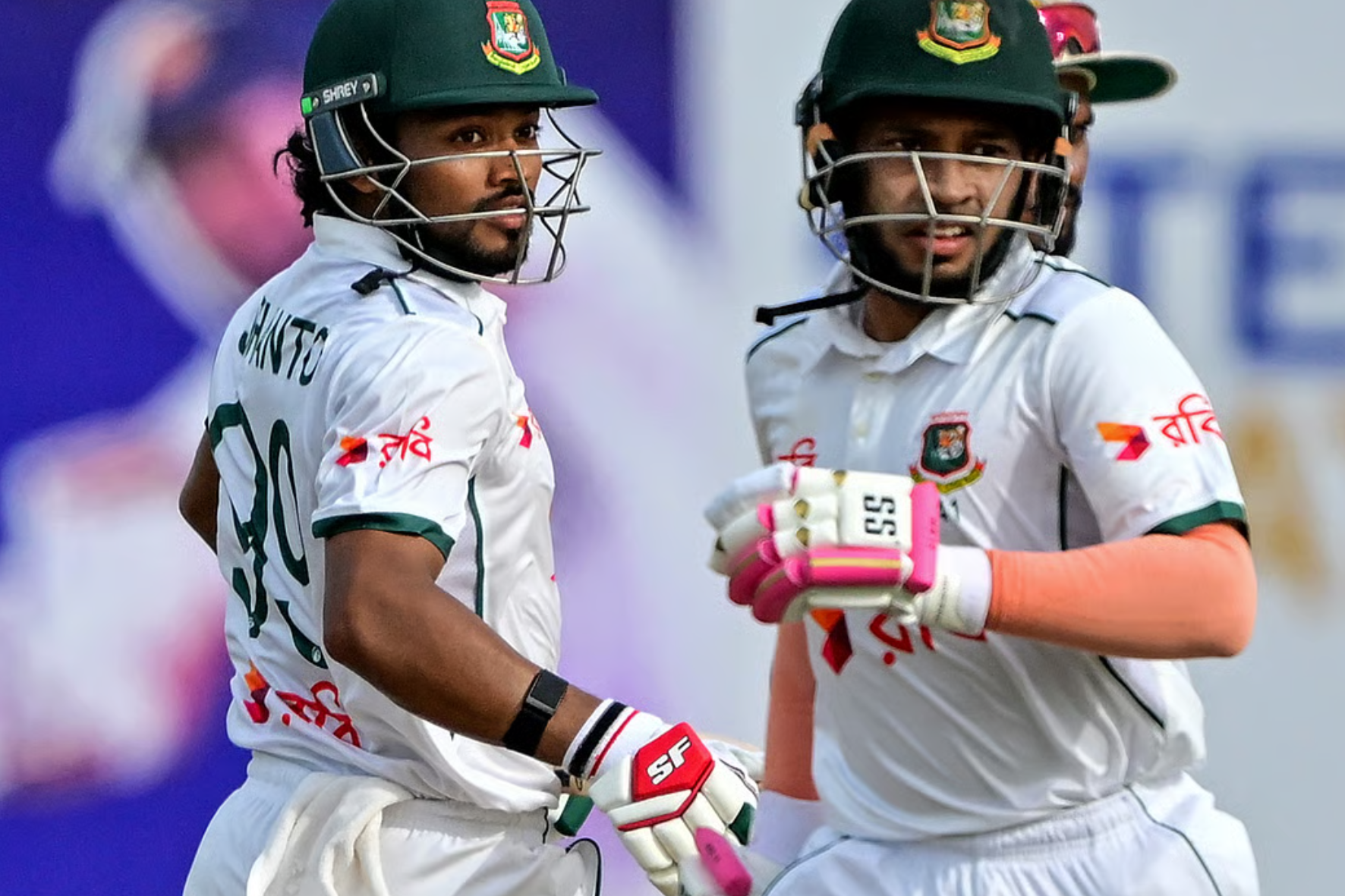Shanto, Mushfiqur Lead Bangladesh Fightback in Galle Test

The first Test between Bangladesh and Sri Lanka got underway at the iconic Galle International Stadium with all the signs of an evenly poised contest. With blue skies overhead and a gentle breeze sweeping across the outfield, Bangladesh elected to bat after winning the toss—a decision that initially appeared questionable. A flurry of early wickets threatened to derail their intentions, but a stunning revival ensued. The tourists ended day one at a powerful 292 for 3, thanks to a historic and commanding fourth-wicket partnership between Najmul Hossain Shanto and Mushfiqur Rahim.
Sri Lanka Strike Early Before Bangladesh Build Momentum
Bangladesh’s top order faced early discomfort, with Sri Lankan pacer Asitha Fernando removing opener Anamul Haque for a duck. An early wobble turned into a full-blown crisis when debutant off-spinner Tharindu Rathnayake picked up two more wickets in quick succession, sending the visitors reeling at 45 for 3. Rathnayake, making his Test debut following a strong domestic season, was the standout early on for the hosts. With the pressure mounting and the pitch showing signs of bite, it looked as if Bangladesh would need a herculean effort to rebuild.
And that effort came—in abundance.
Shanto And Mushfiqur Formulate Bangladesh’s Highest Stand Against Sri Lanka
When Najmul Hossain Shanto and Mushfiqur Rahim came together, Bangladesh were in trouble. The setting demanded patience, precision, and mental toughness. Together, they scripted a phenomenal turnaround. Their 247-run stand not only stabilized the innings but also set a new record for the highest fourth-wicket partnership by Bangladesh against Sri Lanka in Test matches.
Shanto, the Bangladesh captain, led from the front with a masterclass in calculated aggression and composed defense. His confidence at the crease was evident from the outset. Using his feet to great effect against the spinners, he never allowed the bowlers to settle into a rhythm. He reached his sixth Test century and his second against Sri Lanka with a crafty paddle sweep, underlining his rich form and intelligent shot selection.
Mushfiqur Rahim, the veteran campaigner, joined in to produce one of his most memorable innings in recent times.
Mushfiqur Rahim’s Timely Hundred Ends Prolonged Lean Patch
Coming into the match under considerable pressure due to a prolonged poor run—13 innings without a half-century—Rahim answered critics in the best way possible. The 38-year-old wicketkeeper-batter, Bangladesh’s most experienced Test player, summoned all his experience to craft a technically sound and emotionally charged century.
His familiarity with the Galle surface, where he had scored a double century in 2013, was evident. Rahim navigated the conditions with assurance, blending aggressive intent with calm defense. He did have a stroke of luck when debutant Rathnayake dropped him on 25, but to his credit, he capitalized on the chance fully. As he edged toward the milestone, tension grew. But a quick single helped him bring up his 12th Test hundred, met with warm applause from his teammates and applause from the stands.
It was not merely a personal milestone but a statement of resilience and longevity from one of Bangladesh’s cricketing pillars.
Sri Lanka Debuts New Talents and Pays Tribute to a Legend
For Sri Lanka, the day was one of mixed emotions. On the one hand, the debut of two promising domestic players—off-spinner Tharindu Rathnayake and opening batter Lahiru Udara—signaled a new beginning. On the other, it marked the end of an era, with Angelo Mathews playing his 119th and final Test.
Before the match began, a tribute ceremony was held to honor Mathews, one of Sri Lanka’s most celebrated modern cricketers. With over 8,000 runs in the format, Mathews has been a mainstay in the team for nearly 16 years. He stands behind only Kumar Sangakkara and Mahela Jayawardene in Sri Lanka’s all-time Test run-scoring list.
“Playing for the country was always my dream, and I’m extremely proud of my journey,” Mathews said in a heartfelt pre-match address. He added that the moment felt “quite special” and credited everyone who had been part of his cricketing life.
His presence on the field added a deeper emotional resonance to the day’s proceedings, even as the team struggled to contain the partnership between Shanto and Rahim.
Sri Lanka’s Bowling Attack Struggles After Early Promise
Despite the early breakthroughs, Sri Lanka’s bowling attack soon found itself on the back foot. Asitha Fernando’s pace initially caused discomfort, and Rathnayake’s spin brought excitement with his twin strikes, but the inability to break the fourth-wicket stand left the bowlers visibly frustrated.
Left-arm spinner Prabath Jayasuriya, usually reliable on turning tracks like Galle, was kept at bay by the duo’s tactical approach. Shanto was especially nimble, using the crease effectively and punishing any lapse in length. Rahim’s ability to rotate strike and pick singles prevented the spinners from applying prolonged pressure.
Though Rathnayake did snd composure of the two Bangladesh batters ultimately won the day.
Historical Context Adds Weight to Bangladesh’s Recovery
This partnership is not just a numerical achievement—it carries historical and emotional significance. Bangladesh has struggled in Sri Lanka in the past, with Galle being a venue where wins have eluded them consistently. This performance stands out as one of the most determined fightbacks in Bangladesh’s Test history abroad.
Their 247-run partnership now sits atop the fourth-wicket partnerships by a Bangladeshi pair against Sri Lanka, overtaking several past efforts that fell short due to collapses or lack of patience. For a team looking to be more competitive on foreign soil, this performance could mark a turning point.
Implications for the World Test Championship Cycle
This Test match is the opening fixture of the new 2025–2027 ICC World Test Championship cycle. Every run, every session, and every result now counts toward qualification for the final.
By ending day one on 292 for 3, Bangladesh have not only taken early control of the Test but also sent a message of intent. With strong partnerships, disciplined batting, and improved overseas performances, they seem determined to enhance their Test credentials.
For Sri Lanka, the coming days will be about regrouping and finding ways to claw back into the contest. With rain unlikely to intervene, they will need to rely on patience and a disciplined bowling strategy to force errors and engineer a comeback.
Looking Ahead to Day Two and Series Prospects
As day two approaches, all eyes will be on how Bangladesh build upon their strong foundation. With both Shanto and Rahim still unbeaten, the visitors have a real opportunity to post a first-innings total well above 400—possibly higher if the pitch continues to favor batting.
Sri Lanka, meanwhile, will hope for early morning movement or a sudden burst of inspiration to break the stand. The debutants, now settled into their first Test experience, might play a key role in shifting momentum.
The second Test in Colombo, scheduled for June 25, will undoubtedly reflect the trends and performances seen in Galle. But for now, Bangladesh will take satisfaction in silencing doubts and rewriting history, at least for the opening day.
A Day That Belonged to Discipline and Determination
Cricket is often called a game of patience, and day one at Galle was a textbook example. From a shaky 45 for 3 to a dominant 292 for 3, the transformation was built on temperament and skill. Shanto’s poise and Rahim’s defiance made for a compelling narrative—one that celebrated not just numbers but character.
Sri Lanka’s early brilliance gave way to a long day in the field, but the game remains open. The next few sessions will determine whether Bangladesh turn this promising start into a match-winning advantage or if Sri Lanka can craft a twist in the tale.
For now, though, the headlines belong to a record partnership and a day that will be etched into Bangladesh’s Test cricket folklore.







